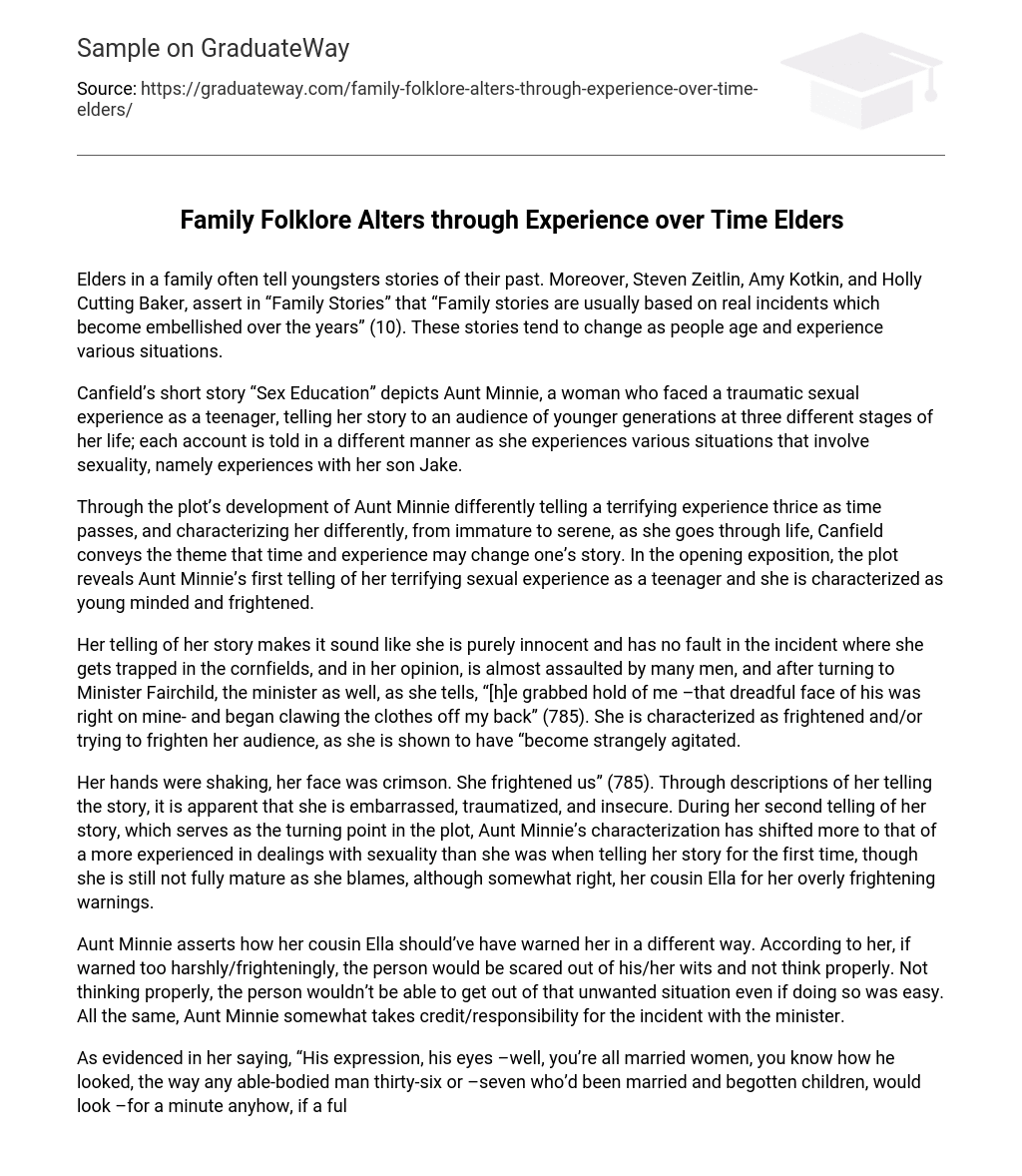Elders frequently share stories from their past with the younger generation. According to Steven Zeitlin, Amy Kotkin, and Holly Cutting Baker in their work “Family Stories,” these stories are typically rooted in actual events but can become exaggerated over time (10). As individuals grow older and encounter different circumstances, these narratives often undergo transformations.
In the short story “Sex Education,” Canfield portrays Aunt Minnie, a woman who endured a distressing sexual encounter during her teenage years. Aunt Minnie shares her tale with three different age groups, highlighting various situations related to sexuality, particularly involving her son Jake. Each account is narrated in a distinct manner as Aunt Minnie navigates through these experiences.
Canfield uses the plot’s development of Aunt Minnie to convey the theme that time and experience may alter one’s story. As the story progresses, Aunt Minnie tells her terrifying experience three times, each time differently. Additionally, she is characterized differently as she grows older – starting off as immature and frightened when she first tells the story as a teenager.
The woman recounts her story in a way that portrays her as completely blameless in the incident. According to her, she was trapped in the cornfields and was almost assaulted by several men. She sought help from Minister Fairchild, who she claims forcefully grabbed her and began tearing off her clothes while their faces were in close proximity. She appears to be either genuinely frightened or attempting to scare her listeners, as she is described as becoming unnervingly agitated.
Her trembling hands and flushed face terrified us (785). The narrative tone suggests she is embarrassed, traumatized, and uncertain. In her second retelling of the story, there is a shift in the plot indicating that Aunt Minnie has gained more understanding of sexuality compared to her initial account. However, she still lacks complete maturity as she partly blames her cousin Ella for the overly frightening warnings, which holds some justification.
Aunt Minnie expresses her belief that her cousin Ella should have provided a gentler warning. She believes that if someone is scared too much, they will not be able to think clearly and therefore will not be able to escape from the unwanted situation, even if it is simple to do so. Nevertheless, Aunt Minnie partly accepts responsibility for the incident with the minister.
She now realizes that when a girl, who looks like she did at the time, unexpectedly embraces a man with force, it will sexually arouse him. This is evident from her description of his expression and eyes, as well as her reference to his marital status and age. In her exact words, she said, “His expression, his eyes – well, you’re all married women, you know how he looked, the way any able-bodied man thirty-six or -seven who’d been married and begotten children would look – for a minute anyhow if a full-blooded girl of sixteen, who ought to have known better flung herself at him without any warning, her hair tumbling down her dress half unbuttoned and hugged him with all her might” (789).
Moreover, her comprehension has been acquired from her interactions with Jake, her challenging son who frequently finds himself in troublesome situations with women. In fact, she has made significant efforts to support him. Regarding sexual understanding and desires, she possesses greater knowledge due to her own personal experiences. Additionally, she handles these matters with increased responsibility and maturity, avoiding impulsive choices that could potentially ruin a man’s life in an instant (789).
Despite being portrayed as moderate and calm, Aunt Minnie remains argumentative and agitated. The story concludes by revealing Aunt Minnie’s age and weariness, with her third and final account of her story in the cornfields presenting a stark contrast to the first. In this depiction, Aunt Minnie is fully cognizant of the connection between sexuality and the dynamics of male and female relationships.
She acknowledges that her interest in the minister is the reason she ran to him and hugged him tightly, confessing that she has been interested in him all along (790). She also explains that the reason she embraced him was partly because she was scared (790), but that wasn’t the only reason she hugged Malcolm Fairchild (790). Aunt Minnie also recognizes that it is not his fault that he had “the look” on his face.
Aunt Minnie is honest and takes responsibility for being lost in the cornfields. She is insightful and knowledgeable about sexuality. In the recent retelling of her stories, Aunt Minnie is described as serene, direct, and even nostalgic about the “horrific” event from her teenage years. In her short story “Sex Education,” Canfield explores how sexual desires and understanding change as people age and encounter different situations involving sexuality. The character of Aunt Minnie represents this exploration through her experiences with her son Jake and her eventual acceptance of the sexual aspect of their relationship. Canfield’s theme that personal narratives can be transformed through life experiences over time aligns with the ideas of Zeitlin, et al.
The bibliography includes the following sources: Canfield, Dorothy’s story “Sex Education” from the collection A Treasury of Short Stories edited by Bemardine Kielty, published by Simon and Schuster in 1947; Zeitlin, Steven J., Amy J. Kotkin, and Holly Cutting Baker’s book “Family Stories” from A Celebration of American Family Folklore, published by Pantheon Books in 1982.





